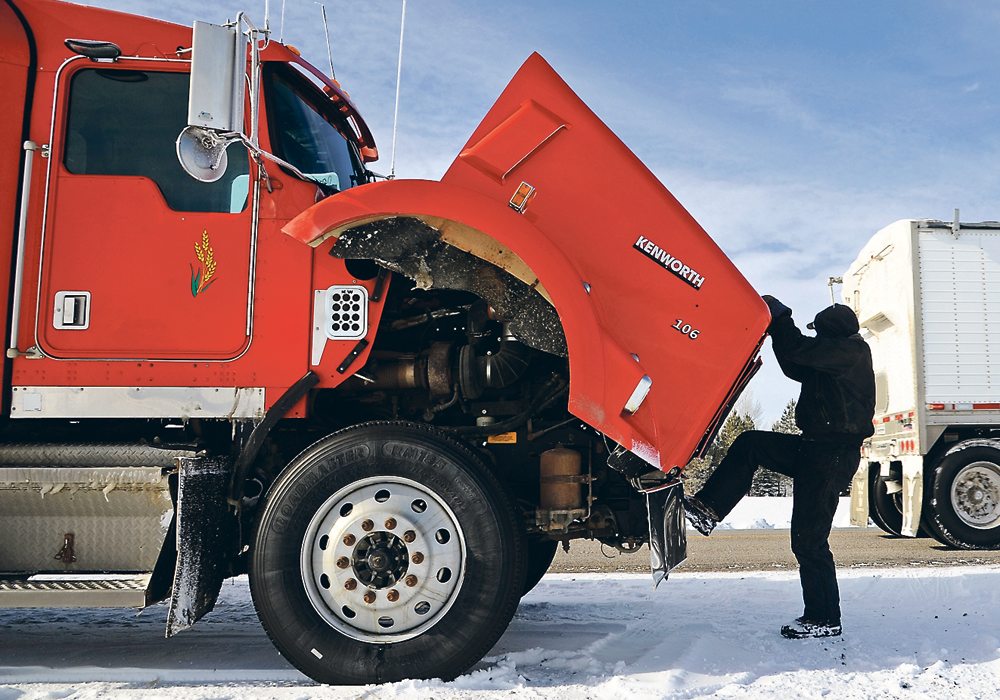 The modern, over-the-road grain hauler or cattle hauler has become an electrical grid unto itself.
The modern, over-the-road grain hauler or cattle hauler has become an electrical grid unto itself.The truck’s total dependence on clean, stable electricity increases with each new model year.
Electricity has replaced belts to drive most compressors and pumps. It’s essential for the ECUs (engine control units), fuel injection, air conditioning, power steering, navigation, display screens, actuators and many other functional devices.
All those computers demand clean electricity. The slightest electrical bump through a sensor can trigger a ripple in the truck that might feel like an earthquake. When a computer stops computing, it sometimes means the rig shuts down.
Electrification is increasing across all motorized industries, according to Roy Karam of Karam Alternator Starter in Saskatoon. Karam started his business in 1984, and services electrical systems on highway and off-road vehicles.
He says the output of alternators is gradually creeping upward to keep pace with the growing electrical demand.
But output is only half the equation. The power has to remain stable.
In addition to the necessities, electricity powers a long list of conveniences such as power windows, heated steering wheels, power seats with both heating and air conditioning, heated windscreens and communications devices.
There’s no arguing with the logic of electrifying the truck. In a conventional system, the ancillary belts, bearings and shafts keep turning even when the pump or compressor isn’t working. That wastes energy and increases maintenance costs. Electric drive eliminates the waste by permitting shafts to spin only when the machine is activated, and only at the r.p.m. that’s needed. Electricity allows precise tuning of all such devices.
“The manufacturers are doing a lot of different things to eliminate load dump. The rate of charge comes on gradually instead of all at once. It’s controlled so the charge might come up over a 10-second span, for instance,” says Karam, adding that a conventional voltage regulator is a simple on-off switch that can damage today’s electrical systems.
“Fine-tuning the charging system is a challenge for electrical engineers. They’re working with a number of variables. They compensate for operating conditions, temperature and electrical demand to make the system as efficient as possible.”
Karam says one recent technological upgrade is simple — battery location. Engineers compensate for battery temperature, depending on where it’s located in the vehicle. Demand on the battery is also a consideration. When the full 14V isn’t required, the alternator can cut back, saving fuel and wear on the bearings.
To reduce the length of serpentine belts, truck manufacturers are bringing belt driven components such as alternators closer to the engine block.
Things like battery location and the length of serpentine belts are typical of the gradual changes in truck electrics. He says there are no giant breakthroughs.
The Denso hairpin winding is another example of the gradual step-by-step evolution of alternators, in response to demand for better charging systems.
The Denso hairpin stator technology delivers more power with less weight and size. Their hairpin alternator is 75 to 80 percent more efficient in testing compared to 50 percent efficiency for S-wound designs. Where conventional S-wound stators use round wires, the hairpin uses custom-fabricated square wire in the 96-slot stator. Square wire eliminates gaps that contribute to dead spots in the alternator rotor-stator interface. The typical round wire stator has 36 slots with a lot of air gaps between the wires. The hairpin stator has 96 slots and no air gaps. This increases the copper-to-steel contact area. More surface contact area means more electricity with less heat.
It produces more power at lower r.p.m. so it lasts longer.
While the advanced electronics and electrical-charging systems make for more efficient and more driver-friendly trucks, the downside is the difficulty in doing your own repairs. Without access to the correct testing equipment and codes, do-it-yourself troubleshooting and DIY repair are nearly impossible.
